|
|
|
Published
on 28
Oct 2008
|
All rights reserved.
|
|
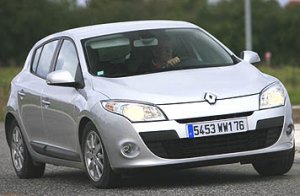
|
To keep Renault alive, the new Megane
has to succeed...
|
French
cars used to be very strong in European market. However, they have been
declining in recent years. The once big selling Peugeot and Renault are
facing sales decline and job cuts because their latest products are not
as popular as their predecessors. The problems at Renault seem
particularly serious – its highly anticipated Laguna III turned out to
be a sales disaster, much the same way as the earlier Modus and Vel
Satis. New Twingo is likely to be another casualty considering its
mediocre reputation. The remaining lifesavers are Clio and Megane. Both
cars perform reasonably well up to now, but their profit margins are
being eaten up by the increasing invasion from Korean and Japanese
cars. To keep Renault alive and the French in the driving seat of
Renault-Nissan group, the new generation Megane has to succeed. But can
it ?
This is the third generation Megane. You might remember the first
generation once challenged Volkswagen Golf as European No. 1 seller.
The second generation stunned us with a radical
semi-sedan-semi-hatchback tail. No matter succeeded or not, they tried
very hard to be outstanding. However, I have a feeling that under the
leadership of Carlos Ghosn, Renault became increasingly conservative.
To save money and keep the company free from risks, Ghosn usually
approves new cars using last generation platforms and standardized
technologies from component suppliers. This is why the Megane III is
built on a development of the Megane II platform. It still employs
torsion-beam rear suspensions, which is a low cost compromised
solution. This might put it in an unfavourable position against the
multi-link camp headed by Ford Focus, Volkswagen Golf, Seat Leon, Skoda
Octavia and even Kia Cee'd and Hyundai i30. It is by no means a French
Revolution.
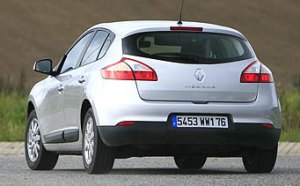
|
Now no longer having a distinctive
design, Carlos Ghosn should be worry.
|
Without
altering the
basic suspension layout, Renault tried to improve its handling and ride
by revising its spring / damper rates, bushings and adopt a stiffer
subframe. Adaptive damping ? Sorry, Renault is yet to understand why
Volkswagen and Opel need this sophisticated technology. Ditto the Sport
/ Normal / Comfort mode control that is increasingly popular in this
class. As for steering, it carries over the last generation's electric
power steering, albeit with slightly quicker ratio to sharpen handling
response. As you can see, there is no reason to believe the new Megane
could challenge the dynamic winners of the class, i.e. Focus and Golf.
Nevertheless, containing the old wine is a new bottle. It appears to be
lower, wider and sleeker than the old car. But it also looks softer and
less distinctive. Renault tried a similar design theme with the current
Laguna, and it has been proved to win few friends. Frankly, I think it
could be another failure. Comparatively, the interior looks much
better. It is light and airy, competitively spacious and elegantly
designed. Mind you, it doesn’t set new standards in materials, fit and
finish and quietness, because the new Volkswagen Golf has raised that
bar again, but this is still a high-quality environment. The upper half
of the whole dashboard is made of soft-touch plastics while there are
many elegant chromed accents. The instrument combines an analogue rev
counter, a backlit digital speedometer and signal display, which looks
quite cool. Best of all, the interior feels very French.
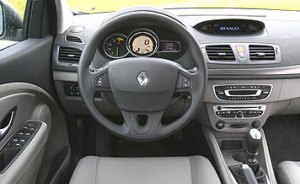
|
The interior feels very French...
|
The new
Megane
is
slightly larger than the last generation, and its wheelbase is 15mm
longer at 2640 mm. This gives its interior slightly more space. The 100
mm increase of length results in a class-leading 405 liters of luggage
space. Fortunately, the larger size has not resulted in more weight. In
fact, Renault claims a reduction of 8 kg. This mean most engines could
be carried over again…
Most customers are likely to choose the 105hp 1.5-liter 8V dCi turbo
diesel engine. While it is not the most refined in its class (gruffy at
high rev), it is punchy and frugal, achieving 60 mpg in European
combined cycle, which is excellent for a C-segment car. It could top
118 mph and accelerate from 0-60 mph in a little over 10 seconds,
perfectly acceptable for an entry-level economy car. It makes more
sense than the 130hp 1.9dCi, which is not much faster.
In the petrol side, you can have Renault's 1.6-liter 16V and 2.0-liter
16V engine. However, you may forget them because they will be replaced
by a new 1.4-liter TCE turbo engine next year. This engine is actually
designed by Nissan in Japan. It employs a small turbocharger plus
intake variable valve timing to produce 130 horsepower and 140 lb-ft of
torque. Quoting Renault's words, it "produces the power of a 1.8-liter
engine, the torque of a 2.0 engine and returns fuel consumption
matching a 1.6 engine". Renault has never been famous for engines, so
Le Cost Killer is right to supplement its weaknesses with what Nissan
does best, and by the way saves substantial costs. That said, the 1.4
TCE misses one crucial technology - direct injection, thus it still
trails Volkswagen's 1.4 TSI engine.
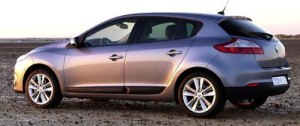
|
It is clearly set up as a comfortable
and relaxed car, just like most other Renaults...
|
On the
road,
the new
Megane feels slightly more responsive than the old car thanks to the
revisions made to its suspension and steering. However, the overall
setup is relatively soft by class standard, which is evident in the
excessive body roll and understeer when you push hard. Undoubtedly,
keen drivers will prefer Focus and Golf. The Renault also dissatisfies
its driver through a notchy gearshift and a not very feelsome steering.
However, Megane III has never tried to pretend to be a sporty car (its
unsophisticated suspensions would not allow even if it do). Instead, it
is clearly set up as a comfortable and relaxed car, just like most
other Renaults. Its soft suspensions deliver cosseting ride,
while all controls are lightweight and easy to operate. Its punchy
diesel engines enables relaxed cruising on highway as long as you don't
urge it. In this view, it is every bit a real French car.
Unfortunately, local rival Peugeot 308 is equally strong in the camp of
refinement yet feels more agile to handle. The new Volkswagen Golf VI
trumps both again in nearly all areas. Now no longer having a
distinctive design, how can Megane III stand the strong competition ?
Will it repeat the failure of Laguna III ? Carlos Ghosn should be
worry.
|
Verdict:    |
| Published
on 17
Nov
2008 |
All rights reserved.
|
|
Megane Coupe
|
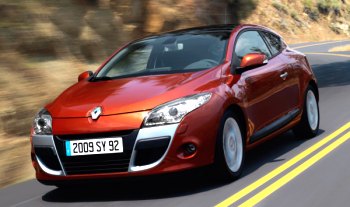
|
Renault wants you to see its 3-door
hatch as a coupe...
|
The
difference between a coupe and a 3-door hatchback is mostly cosmetic,
but the former could charge more money. That is why more and more car
makers try to market their 3-door hatches as coupes, such as Opel Astra
GTC, Volkswagen Scirocco and Seat Ibiza SportCoupe. The latest addition
to the list is Renault Megane Coupe. This car looks stylish thanks to
its wide stance and flowing roofline. The way the upper edge of the
side windows flows smoothly and develops into the lower edge of rear
screen is interesting. Ditto the use of aluminum-effect front intake
panels. It looks radical by the standards of production car.
The Megane Coupe keeps all dimensions unchanged from the 5-door
hatchback except its height, which is reduced by 48mm. This already
include a 12mm drop of ride height, so the rear seat space is still
acceptable to regular size adults. The Coupe shares its dashboard with
the regular car, which means high quality and stylish. What a pity it
is no more special than the 5-door hatch.
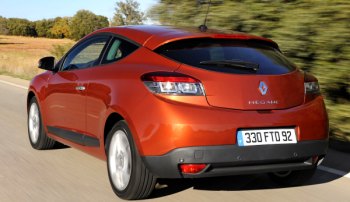
|
The 2.0 TCE engine lacks both
firepower and refinement...
|
Predictably,
the
lower ride height is made possible by stiffening suspensions – spring
rate is up 19% and 12% front and rear respectively. As a result, it
controls body roll more tightly than the regular car. Understeer has
been reduced. The retuned power steering gains weight and precision,
but not radical enough to compensate for its lack of feel. Overall, the
handling is satisfying rather than outstanding. On the plus side, its
ride quality remains good for a coupe.
The engine is more disappointing. Even the top-spec 2.0 TCE turbo
engine with inlet variable valve timing and twin-scroll turbocharger
isn’t exactly firebreathing. Its 180 horsepower arrives at an early
5500 rpm, peak torque even comes at 2250 rpm. This engine hates revving
and will protest with coarse noise at high rev. Keep it at mid-range,
however, it will pull happily. But then a coupe is not supposed to be
so civilized. The engine is apparently underdeveloped. Volkswagen’s TSI
family is far superior.
The Megane Coupe is not really a driver’s car, unlike Volkswagen
Scirocco. While some people may find its looks and cheaper price
tempting, it is not the car we would recommend. |
Verdict:    |
| Published
on 23
Nov
2009 |
All rights reserved.
|
|
Megane RS (Renault Sport)
|
Earlier
this year, Ford Focus RS stunned us by showing how entertaining a
front-wheel drive performance machine can be. However, don't ever think
it must be a default winner. Within half a year, two rivals will
challenge it for the class leader title. They are Renault Sport Megane
and Volkswagen Scirocco R. Now we have a look at the Renault first.
The last generation Renault Megane R26 (and especially the
track-oriented R26R) was highly admired by British motoring
journalists. It showed that Renault Sport has the know-how to build
great driver's cars. The new generation Megane RS is built on its well
established basis. Powering the car is still that well-proven
iron-block 2-liter turbocharged four-pot engine, but it gets revised
intake ports, twin-scroll turbo, new piston rings, sodium-cooled
exhaust valves, reinforced pistons and conrods and the addition of
intake variable valve timing to boost horsepower from 230 to 250.
Torque also increased from 229 to 251 pound-foot. Coping with only 30
kg weight gain of the whole car, it guarantees higher performance -
0-60 mph now takes a respectable 5.8 seconds. Top speed hits 155 mph.
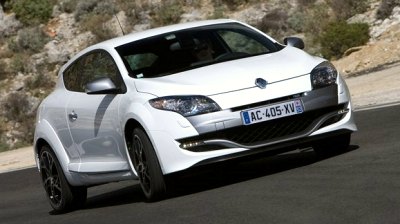
|
Renault's RS challenges Ford's RS as
the best front-drive hot hatch in the world...
|
Nevertheless, in terms of performance Ford Focus RS is even stronger.
Thanks to its larger 2.5-liter five-pot engine, it produces 55 more
horsepower and 73 more pound-foot of torque than the Renault. This
mean, although Megane RS is 80 kg lighter and have a smaller frontal
area, it can hardly keep up with the Ford once the latter open its
throttle wide. Moreover, its flat power delivery is no where as
exciting as Ford's. You get a slight turbo lag at low rpm, then it
picks up quickly at around 2000 rpm and remains committed until peak
power occurs at 5500 rpm. Beyond that, you get little reward no matter
for power or sound. Ultimately it will cut off fuel supply at 6500 rpm,
550 rpm lower than the Ford engine. Megane RS is not short of
performance, but its engine lacks character.
Another
weakness is its
6-speed manual gearbox. Its gearshift is vague, and its throw is too
long. A shame that Renault claimed the gearbox is new.
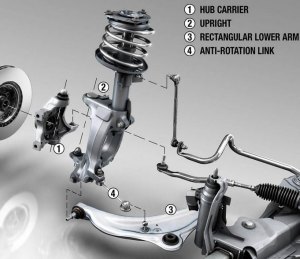
|
PerfoHub struts is similar to Ford's
RevoKnuckle in construction and theory...
|
Comparatively,
the chassis is more remarkable. Although its
torsion-beam rear suspension is not an optimum choice, Renault Sport
has replaced the front MacPherson struts of the regular Megane with a
sophisticated setup they called "PerfoHub struts". Its construction and
theory is similar to Ford's RevoKnuckle - by separating the steering
axis from the shock absorber, King-pin offset is reduced from the
regular car's 56 mm to 40 mm. The result is reduced torque steer. In
fact, PerfoHub strut is not new to Renault. A similar design was
already presence in the last generation Megane RS from 2004. However,
this time the new car uses aluminum to construct the front suspensions'
hubs, hub carriers and lower control arms, greatly reducing unsprung
weight hence improving ride quality. Besides, the front suspension
subframe is made 3 times stiffer in order to maintain suspension
geometry under high cornering load.
Compared with Ford, Renault Sport cares more about track-days drivers.
Besides the standard Megane RS, it also offers a Cup model which has
all the hardcore tunings - less equipment, lightweight Recaro seats,
stiff suspension setup (springs stiffened by 35 and 38% front and rear
respectively !), lower ride height, a standard helical limited slip
differential and stickier Michelin Pilot Sport rubbers. The standard
car already has very good brakes - Brembo 4-pot calipers and 340mm
discs up front and 290 mm discs at the rear. In the case of Cup, the
discs are grooved and the servo has been retuned to give stronger
stopping power again.
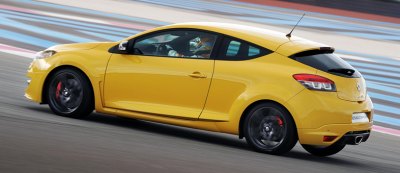
|
Despite of its power deficit, it can
easily keep up with Focus RS in the twisty...
|
On the
road,
the Cup shines in the way it corners. Despite of its power deficit, it
can easily keep up with Focus RS in the twisty. Thanks to a lower roof
and seating level, its body control is even more impressive than the
Ford. It also displays excellent grip and braking. The steering is more
refined than the previous R26, but it is still highly accurate and will
beautifully load up in corners. You can trust the helm because torque
steer is virtually eliminated, even cleaner than Focus RS - admittedly,
its front wheels have less torque to cope with. Coupling to the LSD and
an unintrusive multi-stage ESP, the car is highly capable in the
twisty. You can apply power early out of corner without causing
wheelspin or too much understeer. It turns into bend so fluently.
While the handling is first rate, ride quality and running refinement
is still markedly improved from the old car. The aluminum suspension
components and Megane III chassis are more than capable to compensate
for the stiff suspension setup of the Cup model. It is not as
comfortable as Ford, but more forgiving than Mazda 3 MPS. In case of
the standard RS model, the level of ride comfort is even more
remarkable. It feels a much more grown up car than Ford, thus is a
better companion for long distance journey. However, the soft setup
does hurt its steering keenness and degrade its overall sharpness.
Unless you have backache, Cup model will be the better choice.
That said, the chassis of Megane RS begs for a better engine. It needs
more power and a more exciting character to match the excellent
handling. Before that is fulfilled, Ford Focus RS is still the better
driver's car. |
Verdict:     |
| Published
on 27
May 2010 |
All rights reserved.
|
|
Megane Coupe Cabriolet
|
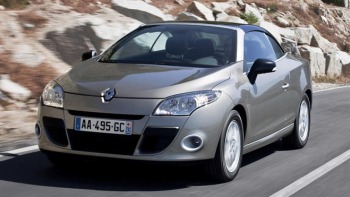
|
Renault still bet on the future of
coupe-cabriolets...
|
Is Coupe Cabriolet a
thing
of the past ? Renault is one of the few car makers still bet on its
fortune. The new generation Megane CC follows its predecessor to employ
a two-piece retractable glass roof. No wonder most of the disadvantages
are retained, for example:
- an intrusive windscreen header;
- a pair of rear seats whose head and knee room are more suitable to
children;
- a massively long tail necessary to store the bulky roof mechanism;
- a weight gain of 160 kg over the equivalent Megane;
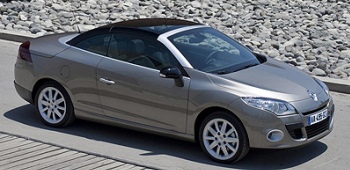
|
Two-piece glass roof is retained...
ditto the packaging deficiencies...
|
In other
words, it has not corrected the deficiencies of its packaging. What it
improved are on other areas. The exterior design based on Megane Coupe
is slightly more interesting than the old car. The visual and actual
quality – like the rest of the Megane family – is vastly improved, as
is equipment and refinement. Torsional rigidity of its chassis is a
massive 80 percent up. Stiffer suspension setting results in less body
motion. Downsized turbocharged engines are greener. Beefed up diesel
engines produce more power and torque. Overall, you will find a much
more refined car on the road. Mind you, it is still boring to drive,
because of its weight, understeer, inert steering etc. Renault is
sensible not to emphasize driver appeal, but tuned it to deliver
comfort and refinement in first place. It's a relaxing drive,
especially with the torquey 2.0 turbo diesel engine.
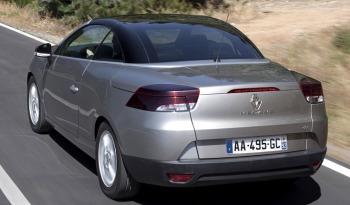
|
Renault is sensible not to emphasize
driver appeal...
|
Still,
there
are better alternatives. Soft-roof rivals like Audi A3 Cabriolet and
BMW 1-series Cabriolet have less compromises in packaging yet deliver
better dynamics. If you insist retractable roof, Volkswagen Eos is
still our first choice. |
Verdict:    |
| Published
on 6
May
2012 |
All rights reserved.
|
|
Megane facelift 2012
|
Renault
has given its Megane range a desperately needed facelift this year. The
cosmetic refinement is quite obvious at the nose. In the mechanical
side, it introduces a range of "Energy" engines to cut fuel consumption
and emission. Most notable of which is the new 1.2TCe alloy-block
petrol engine which has direct injection, light-pressure turbo,
low-friction components, variable capacity oil pump and automatic
stop-start. It replaces the long-serving 110 hp 1.6. The diesel engines
are also improved. 1.5dCi now produces 110 hp and 191 lbft accompanied
with CO2 emission of only 95 grams per
km. New 1.6dCi produces the best in class output, i.e. 130 hp and 236
lbft. Both also get automatic stop-start to save fuel. |
Verdict:    |
| Published
on 7
May
2012 |
All rights reserved.
|
|
Megane RS (Renault Sport) 265
|
Many people praised
last
year's Renaultsport Megane 265 Trophy as the best driving hot hatch in
the world or even the best front-wheel-drive machine ever seen. It also
set a new Nurburgring lap record for FWD cars at an incredible 8
minutes and 8 seconds. Unfortunately, it was a limited edition with
only 500 cars destined to the market. We missed it. Now we have a
second chance, because the Trophy reemerges as Megane RS 265 this year.
It supersedes the Megane RS 250 as Renault's flagship production hot
hatch.
Compare with RS 250, the RS 265's main advantage is extra punch, of
course. When you switch the dynamic management to Sport mode, the
revised ECU allows a higher boost pressure of up to 1.5 bar. In
conjunction with a revised intake system, the 2-liter turbo engine
releases another 15 horses and 14 pound-foot of torque. This lifts top
speed beyond the usual 155 mph to 158 mph, and cuts a tenth in 0-60 mph
acceleration. The gain in performance is nothing dramatic, but you can
definitely feel the extra grunt when accelerating out of corners. The
deeper, angrier exhaust note also enhances the thrilling experience.
As before, the car is available in standard form or Cup version. The
former has all the creature comfort you expected for a daily-use road
car. The Cup is more track-oriented. It gets considerably stiffer
suspensions (35% and 38% stiffer front and rear respectively), a
helical torque-biasing limited slip differential, sports buckets,
grooved
disc brakes and wider (235/40R18) Michelin PS2 rubbers, besides a few
cosmetic enhancements. Despite that, the Cup chassis is still livable
on normal roads, thus it is recommended for hardcore drivers.
We always admire the Megane RS' chassis dynamics. It is very well
balanced. Power is well laid down to the road thanks to excellent
traction. The grip it generates is mighty, allowing very high cornering
speed, yet it will obey your commands for sliding through corners. Its
steering is responsive and amazingly communicative for an EPS. Torque
steer is largely eliminated by the sophisticated PerfoHub front
suspensions. The brakes are strong and well tuned. To this date the
Megane RS still gets the best chassis in the front-wheel-drive world.
All these advantages are carried over intact to the RS 265.
Admittedly, the improvement from RS 250 to RS 265 is small. It is
mainly the extra power and noise that overshadow the old car, yet they
are hardly headlines. However, now that Ford Focus RS has gone and the
aging (but still brilliant) Lancer Evo X is set to retire soon, maybe
it is time to recalibrate our scale. As far as affordable hot hatches
is concerned, nothing compares to the Renaultsport for pure driving
thrills. None can match its real-world speed, too. These two merits are
already enough to earn it top marks. |
Verdict:      |
| Published
on 11
Jul
2014 |
All rights reserved.
|
|
Megane RS 275 Trophy
|
|
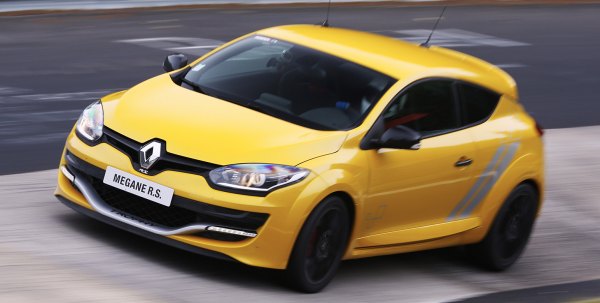
|
Although Megane RS is
approaching the end of its lifecycle, it is still the most thrilling
hot hatch in the world. While rivals like Mercedes A45 and VW Golf R
are more powerful and significantly faster, the Renaultsport is more
capable in the twisty thanks to its sophisticated front suspension and
well-tuned chassis. No matter balance, throttle adjustability and
steering feel it is still second to none.
The Megane’s Nurburgring lap record for front-wheel-drive cars at 8:07
was recently surpassed by a specially prepared Seat Leon Cupra 280. To
take the title back, Renaultsport built a limited edition called RS 275
Trophy-R. It has improvements like 10 extra horsepower (thanks to
remapped ECU and high-flow titanium exhaust), stripped out interior
(which is part of the package to cut 100 kg from kerb weight), Ohlins
adjustable dampers, stronger brakes and
sticky Michelin Pilot Sport Cup 2 rubbers. Consequently, it raised the
bar to 7:54, a figure eclipsing the first Porsche 911 GT3! However, as
the Trophy-R is too costly to build, it is not
destined to mass production. Therefore Renaultsport also introduces a
more affordable version, RS 275 Trophy, to serve its fans.
The production RS 275 Trophy does not have the dramatic weight
reduction that hurts comfort and usability – who can live without sound
insulation, audio system and air-conditioning these days? It doesn’t
weigh any lighter than the old car, but it does sports the 275 hp
engine and titanium exhaust, which produces a bassier note at low rev
and an angrier howl at high rev. Anyway, on the road it is
difficult to tell the extra power, because 10 hp isn’t a lot after all,
and its peak torque remains unchanged at 265 lbft. In other words, it
is still
hopeless to catch A45 and Golf R in highway chase.
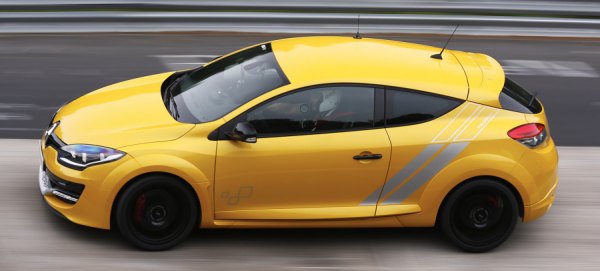
|
What you will notice is the enhanced grip and better body control. The
RS 275 gets the semi-slick Michelin rubbers from its record-breaking
version thus it corners with amazing prowess, even though at the cost
of durability. This makes it a very effective track-days tool. Equally
effective are the Ohlins dampers, which cost another £2000 to
fit. Like the ones fitted to the recent Volvo S60/V60 Polestar, they
employ dual-flow valve technology to deal with impacts of different
speeds, thus they can react more quickly for both compression and
rebound, keeping the wheels in contact with the road. Moreover, they
can be adjusted (manually with tools) to suit different roads and
tracks. With these sophisticated dampers, no wonder the car rides with
outstanding composure and suppleness on difficult roads.
However, what makes the Megane unparalleled in terms of pure driving
thrills is its perfect combination of all things – the steering,
throttle, chassis balance, tires, brakes, gearshift, LSD and suspension
all work seamlessly to serve the driver, responding positively and
encouraging you to go harder and harder. Yes, the engine is not too
powerful and the interior is quite outdated, but if all you care is
driving fun, not even the Golf R and A45 can match it. Age fails to
take its edge off.
|
Verdict:      |
| Published
on 7
Nov
2014 |
All rights reserved.
|
|
Megane RS 275 Trophy-R
|
|
15 years ago, the
first Porsche 911 GT3 set a lap time in Nurburgring north ring at 7
minutes and 56 seconds. That was the first time a production car did
that under 8 minutes. Since then many car makers joined the race to do
better lap times in Nurburgring. While the limelight always fall on
supercars and lightweight sports cars, few notice that affordable hot
hatches also creep towards the once magic 8-minutes barrier. In 2011,
Renault Megane RS 265 Trophy pushed the front-wheel-drive production
car record to 8 min 8 sec. In March this year, Seat released a video
showing its Leon Cupra 280 did the lap in 7 min 58.4 sec, though that
particular car was installed with different aero, brakes and tires
package than what you can buy straight from showrooms. Soon afterwards,
Renaultsport raised the bar again to 7 min 54.36 sec, and this time you
can buy the same car from its dealers. It is Megane RS 275 Trophy-R.
Derived from the production RS 275 Trophy revealed at the same time,
the Trophy-R is a special edition with production limited to 250 cars.
It is by no means cheap at £39,000, or equivalent to an
entry-level Porsche Boxster, but then again no Boxsters can be as
quick.
The engine is practically the same as before. Its maximum output of 275
hp and 265 lbft is no longer appealing by the new class norms, but this
is still a good motor with smooth power delivery and a sporty exhaust
note, thanks to that titanium exhaust. What makes a noticeable
difference is weight reduction. The Trophy-R is 100 kg lighter than the
production version, thanks to the use of thin polycarbonate bucket
seats (which saves 22 kg), the deletion of rear seats (-20 kg), sound
insulation (-18 kg), air-con and radio (-10 kg), the use of lithium-ion
battery (-16 kg), titanium exhaust (-4 kg), lighter yet larger 19-inch
wheels (-5 kg), composite springs (-2 kg) and dual-cast brakes (-3 kg).
Equally influential are the Ohlins adjustable dampers, larger (350 mm)
front brakes and Michelin PS Cup 2 tires, all of which are costly but
very effective to enhance handling.
On the road, the Trophy-R is more hardcore than the production version.
The ride is inevitably harsher on bumpy roads, but it is far from
unbearable. The seat of the pants telegraphs more information to the
driver, as is the precise and communicative steering. Thanks to the
diet and the sticky rubbers, the car turns in more sharply, grips
harder and allows you to carry higher speed through corners. The
balance remains perfect. The upgraded brakes shed speed more quickly
and are more resistant to fade. In short, the Trophy-R feels more a
road-going race car. Yes, it might be overpriced for a Megane, but you
can hardly find a car at any prices more fun to drive and easier to
exploit performance on normal roads.
|
Verdict:      |
|
|
|
|
|
|
|
|
|
|
Megane
1.4TCe
|
2008
|
Front-engined,
FWD
|
| Steel monocoque |
| Mainly steel |
| 4295 / 1808 / 1471 mm |
| 2641 mm |
Inline-4
|
| 1397 cc |
DOHC 16 valves, VVT
|
Turbo
|
| - |
| 130 hp |
| 140 lbft |
6-speed manual
|
F: strut
R: torsion-beam
|
-
|
| 205/55R16 |
1205 kg
|
124 mph (c)
|
9.0 (c)
|
| - |
|
Megane
1.9dCi
|
2008
|
Front-engined,
FWD
|
| Steel monocoque |
| Mainly steel |
| 4295 / 1808 / 1471 mm |
| 2641 mm |
Inline-4, diesel
|
| 1870 cc |
SOHC 8 valves
|
VTG turbo
|
| CDI |
| 130 hp |
| 221 lbft |
6-speed manual
|
F: strut
R: torsion-beam
|
-
|
| 205/55R16 |
1310 kg
|
127 mph (c)
|
9.1*
|
| 29.6* |
|
Megane
Coupe 2.0TCe
|
2008
|
Front-engined,
FWD
|
| Steel monocoque |
| Mainly steel |
| 4295 / 1808 / 1423 mm |
| 2641 mm |
Inline-4
|
| 1998 cc |
DOHC 16 valves, VVT
|
Turbo
|
| - |
| 180 hp |
| 221 lbft |
6-speed manual
|
F: strut
R: torsion-beam
|
-
|
| 205/45R17 |
1320 kg
|
142 mph (c)
|
7.5 (c)
|
| - |
|
|
|
|
|
Performance
tested by: *Autocar
|
|
|
|
|
|
|
Megane
RS Cup
|
2009
|
Front-engined,
FWD
|
| Steel monocoque |
| Mainly steel |
| 4299 / 1848 / 1435 mm |
| 2636 mm |
Inline-4
|
| 1998 cc |
DOHC 16 valves, VVT
|
Turbo
|
| - |
250 hp / 5500 rpm
|
251 lbft / 3000 rpm
|
6-speed manual
|
F: PerfoHub strut
R: torsion-beam
|
-
|
| 235/40YR18 |
1387 kg
|
155 mph (c)
|
5.8 (c) / 6.0*
|
| 13.7* |
|
Megane CC 2.0dCi
|
2010
|
Front-engined,
FWD
|
| Steel monocoque |
| Mainly steel |
| 4485 / 1811 / 1434 mm |
| 2609 mm |
Inline-4, diesel
|
| 1995 cc |
DOHC 16 valves
|
VTG turbo
|
| CDI |
| 160 hp |
| 280 lbft |
6-speed manual
|
F: strut
R: torsion-beam
|
-
|
| 225/45R17 |
1625 kg
|
133 mph (c)
|
8.8 (c)
|
| - |
|
|
|
|
|
|
| Performance
tested by: *Autocar |
|
|
|
|
|
|
Megane 1.2TCe
|
2012
|
Front-engined,
FWD
|
| Steel monocoque |
| Mainly steel |
| 4302 / 1808 / 1471 mm |
| 2641 mm |
Inline-4
|
| 1198 cc |
DOHC 16 valves, DVVT
|
Turbo
|
| DI |
| 115 hp |
| 140 lbft |
6-speed manual
|
F: strut
R: torsion-beam
|
-
|
| 205/55R16 |
1205 kg
|
118 mph (c)
|
10.2 (c)
|
| - |
|
Megane 1.6dCi
|
2012
|
Front-engined,
FWD
|
| Steel monocoque |
| Mainly steel |
| 4302 / 1808 / 1471 mm |
| 2641 mm |
Inline-4, diesel
|
| 1598 cc |
DOHC 16 valves
|
VTG turbo
|
| CDI |
| 130 hp |
| 236 lbft |
6-speed manual
|
F: strut
R: torsion-beam
|
-
|
| 205/55R16 |
1320 kg
|
124 mph (c)
|
9.2 (c)
|
| - |
|
Megane RS 265 Cup
|
2012
|
Front-engined,
FWD
|
| Steel monocoque |
| Mainly steel |
| 4299 / 1848 / 1435 mm |
| 2636 mm |
Inline-4
|
| 1998 cc |
DOHC 16 valves, VVT
|
Turbo
|
| - |
265 hp / 5500 rpm
|
265 lbft / 3000-5000 rpm
|
6-speed manual
|
F: PerfoHub strut
R: torsion-beam
|
-
|
| 235/40YR18 |
1387 kg
|
158 mph (c)
|
5.7 (c) / 5.6* / 5.7** / 5.8***
|
13.2* / 13.2** / 13.4***
|
|
|
|
|
|
Performance
tested by: *Auto Zeitung, **Auto Bild, ***Sport Auto
|
|
|
|
|
|
|
Megane RS 275 Trophy
|
2014
|
Front-engined,
FWD
|
| Steel monocoque |
| Mainly steel |
| 4299 / 1848 / 1435 mm |
| 2636 mm |
Inline-4
|
| 1998 cc |
DOHC 16 valves, VVT
|
Turbo
|
| - |
275 hp / 5500 rpm
|
265 lbft / 3000-5000 rpm
|
6-speed manual
|
F: PerfoHub strut
R: torsion-beam
|
-
|
| 235/40YR18 |
1379 kg
|
158 mph (c)
|
5.7 (c)
|
-
|
|
Megane RS 275 Trophy-R
|
2014
|
Front-engined,
FWD
|
| Steel monocoque |
| Mainly steel |
| 4299 / 1848 / 1435 mm |
| 2636 mm |
Inline-4
|
| 1998 cc |
DOHC 16 valves, VVT
|
Turbo
|
| - |
275 hp / 5500 rpm
|
265 lbft / 3000-5000 rpm
|
6-speed manual
|
F: PerfoHub strut
R: torsion-beam
|
-
|
| 235/35YR19 |
1280 kg
|
158 mph (c)
|
5.5 (c)
|
-
|
|
|
|
|
|
|
Performance
tested by: -
|
|
|
|
|
|
|
|
|
Copyright©
1997-2014
by Mark Wan @ AutoZine
|
|